Authored by Darlene McCormick Sanchez via The Epoch Times (emphasis ours),
In arid South Texas, home to mesquite and cacti, it hasn’t been uncommon for commercial beekeeper Robert Wheeler to lose half his bees every year.
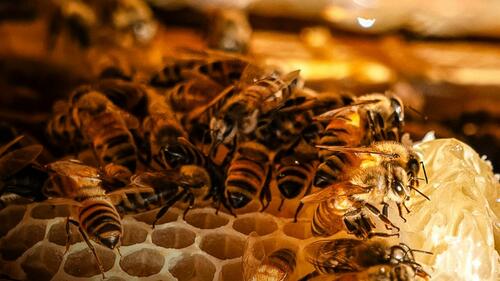
But this year has been far worse.
His family-owned Frio Country Farms lost 2,000 of its 3,000 bee hives this year, many of which would have been pollinating crops such as watermelon and almonds had they lived.
And he is not alone. America’s bees are dying at an alarming rate as scientists try to figure out why.
The main suspect is the deadly Varroa mite, a vampiric parasite that carries viruses and has become immune to Amitraz, the primary pesticide used to kill it.
Wheeler, a commercial beekeeper since 2019, said he is one of many in his trade who relied on Amitraz to keep his colonies healthy.
“Some big beekeepers are hurting pretty bad right now because it takes a lot of money to run a big bee operation, and you can’t have a mistake because it’ll cost too much,” Wheeler told The Epoch Times.
“It is a pretty big deal what’s going on,” he said. “I mean, everything we eat is pollinated.”
Bee Crisis
Viruses spread by the Varroa mite, a devastating parasite that pierces the bodies of bees to drink their blood and nutrients, are the chief suspects, according to a U.S. Department of Agriculture (USDA) press release issued in June.
Scientists examined mites from collapsed colonies across western states in February and discovered signs of resistance to Amitraz, a critical miticide widely used by beekeepers.
“This miticide resistance was found in virtually all collected Varroa, underscoring the need for new parasitic treatment strategies,” according to the agency.
The agency stated commercial beekeepers lost 1.7 million colonies, amounting to more than a 60 percent loss from summer 2024 through January. The economic impact was estimated at $600 million.
Some beekeepers reported 80 percent or more hive losses, according to bee surveys.
A survey carried out by the Apiary Inspectors of America noted “staggering” colony losses of more than 55 percent in a 12-month period ending April 1.
The survey report said the losses were the highest reported since the annual survey first began tracking them in 2010–2011.
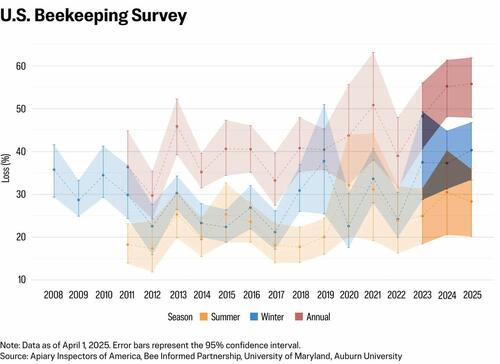
“Experts warn that without immediate intervention, the ripple effects could drive up costs for farmers, disrupt food production, and shutter many commercial beekeeping operations,” according to a joint press release from the Honey Bee Health Coalition, released this spring in reaction to the losses.
“In January 2025, beekeepers across the country began reporting unexpected large-scale honey bee losses—we now know the largest ever recorded in the U.S.,” Danielle Downey, executive director of Project Apis m., stated in the same release.
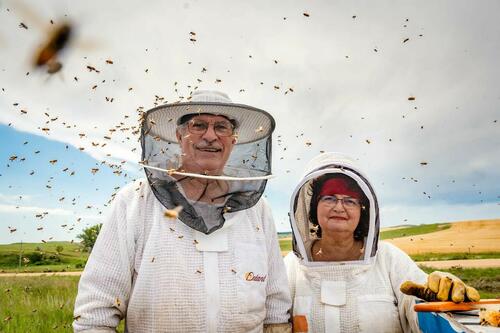
In July, USDA Secretary Brooke Rollins announced a reorganization plan that includes the relocation of the Beltsville Agricultural Research Center in Maryland.
The center holds the country’s bee lab, a frontline research facility studying Varroa mites.
The Epoch Times did not receive a response from the USDA concerning the details of how the relocation might affect bee research.
Impact on Beekeepers
In Texas, beekeeping has undergone a renaissance thanks to a 2012 law that grants property tax breaks to landowners who keep bees on at least five acres.
A conservative estimate puts the number of Texas beekeepers at 6,000, including backyard beekeepers, “sideliners,” or medium-sized beekeepers with small businesses, and commercial bee operators.
In the state, however, the average loss stands at 61 percent over the past year, according to preliminary survey results from the Apiary Inspectors of America.
That rate has typically been more than 40 percent in recent years, far above the expected loss of about 25 percent, according to Garett Slater, an entomologist researching bees at the Texas A&M AgriLife Research and Extension Center at Overton, Texas.
“They’re relying on Amitraz, and it’s not working,” Slater told The Epoch Times. “Their mite levels are exploding.”
The consequences could be far-reaching since crops such as carrots, onions, blueberries, apples, cucumbers, melons, and almonds depend on bees for pollination.
Slater said about a third of food crops rely on bees for pollination.
“If you ever go to your grocery store … those shelves would look pretty bare if we can’t have bees for pollination,” Slater said.
Commercial beekeepers—generally those with more than 300 colonies—have been hit particularly hard, making it difficult to provide bees for California almond crops, where operators can make $250 per hive.
About 80 percent of the world’s almonds are produced in California, which require 80 billion insects, or 1.7 million hives, for pollination.
“These losses are more widespread than ever before,” Slater said. “They’re experiencing probably the highest loss we’ve ever received for the commercial beekeepers.”
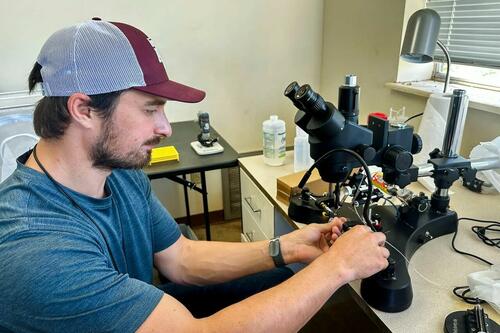
Researchers are just now getting the data they need to assess the impact on almond pollination, he said.
Some beekeepers may be unable to stay in business if they sustain high bee losses year after year, though many split their hives to rebuild numbers.
“But 80 percent losses—it’s really hard to take that 20 percent to make up for that 80 percent loss,” Slater said.
Slater’s job, which was created at the university last year, will support beekeepers and promote good practices across the state.
He is also starting Texas’s first bee breeding center—one of a handful in the country, he told The Epoch Times.
The goal is to breed queens that produce bees that destroy Varroa mites within a colony.
However, nationwide bee losses can’t be entirely explained by the unchecked spread of pesticide-resistant Varroa mites. Some believe pesticides and herbicides weaken the bees, along with poor nutrition, making them more susceptible to viruses.
Corneliu Prelipceanu, a commercial beekeeper in California’s Bay Area, does not use Amitraz, and still suffered high losses. He uses organic pesticides such as formic acid and oxalic acid to kill the mites.
Prelipceanu experienced his worst year since 2010, when he started his company, Elsi Bees.
This past year, he lost 50 percent of his hives, significantly higher than the normal 20 to 30 percent loss, he said.
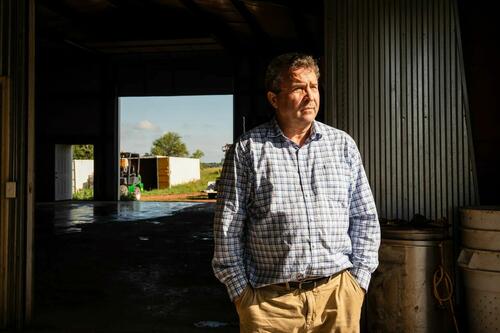
Blood-thirsty Mites
Of all the threats that bees face, the Varroa mite has proven to be one of the most lethal since arriving in the United States in 1987.
They feed on the body fat and blood of bees, and also spread the deadly deformed wing virus, according to a study published by the National Institutes of Health.
“Mites are basically like having a plate-sized parasite on your chest if you’re a bee,” Slater said.
Beekeepers began using insecticides such as coumaphos to kill the mites, but they became immune to the treatments around 2005, he said.
They eventually switched to the insecticide Amitraz to kill the mites, which they’ve continued to use over the past 20 years. It’s a popular, widely used insecticide used in agriculture and veterinary medicine to control fleas and ticks.
While there are alternatives to Amitraz, they pose problems for some beekeepers.
Beekeepers can use organic pesticides such as oxalic acid, formic acid, and thymol, Slater said. But it can be a problem in warm southern states because formic acid and thymol can’t be used once the temperature rises above 85 degrees Fahrenheit.
As for oxalic acid, it won’t kill the mites that hatch inside the cells where they begin to feed on bee larvae and pupae.
Read the rest here…
Loading recommendations…


